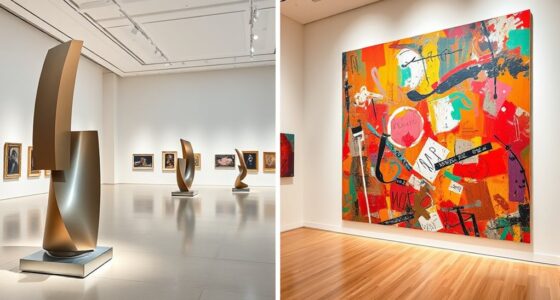Participatory art invites you to become an active part of the creative process, blurring the line between artist and audience. Instead of just observing, you engage through interactive installations, collaboration, and shared decision-making. By contributing ideas or actions, you help shape the artwork’s evolution, creating a deeper personal and emotional connection. Exploring this approach shows how you can transform passive viewing into meaningful involvement—keep exploring to discover how these practices can inspire communities and individuals alike.
Key Takeaways
- Participatory art transforms audiences from passive viewers into active contributors shaping the artwork.
- Interactive installations respond to participant inputs, fostering exploration and a personalized experience.
- Community involvement in participatory art promotes shared ownership, reflection of local identity, and collective creativity.
- Incorporating sustainability and well-being practices enhances engagement and highlights eco-friendly and health-conscious values.
- It breaks traditional hierarchies, empowering diverse voices, and fostering inclusion, ownership, and emotional connection in the creative process.

Have you ever wondered what happens when art invites you to become part of the creation? It’s a powerful experience that blurs the line between artist and audience, transforming passive viewers into active participants. Participatory art thrives on this engagement, creating opportunities for genuine interaction and collaboration. One of the most enthralling forms of this is the interactive installation, where you don’t just observe but become physically involved in the artwork. These installations often incorporate sensors, projections, or physical elements that respond to your movements, sounds, or inputs. As you step into such a space, you’re no longer a distant viewer; you’re part of the artwork’s evolving story. This interactive dynamic invites you to explore, experiment, and even influence the piece’s development, making each experience unique. It’s not just about appreciating art but about becoming an active contributor, which deepens your connection to the piece and its message. Engaging directly with art can also foster a sense of emotional connection that enhances personal meaning.
Community involvement is a key component of participatory art that makes it even more impactful. When artists design projects that include local residents, students, or diverse groups, they foster a sense of shared ownership and collective creativity. This approach transforms the artwork into a reflection of the community’s identity, concerns, and aspirations. For example, a mural project might invite community members to add their own images or messages, turning a public space into a canvas of collective expression. Such initiatives not only produce meaningful art but also strengthen community bonds, promote dialogue, and empower participants. They break down traditional barriers between artist and audience, recognizing everyone as a co-creator. When you’re involved in community-based participatory art, you’re contributing to a larger narrative that’s shaped by multiple voices, making the final piece more authentic and resonant. Additionally, incorporating renewable energy sources into the creation process can demonstrate sustainable practices within community art projects, inspired by innovative technology that enhances engagement. This integration of sustainable practices echoes the importance of well-being tips, such as maintaining a healthy environment, in fostering overall community resilience. Understanding the physical and mental benefits of engaging in creative activities, like yoga, can further strengthen community well-being and participation.
Participatory art also invites a shift in how we perceive our relationship with creativity. Instead of being spectators, you become collaborators, shaping the outcome through your actions and ideas. This process encourages a sense of ownership and agency, allowing you to see yourself as part of a larger artistic community. Whether it’s a workshop, a public installation, or a collaborative performance, your participation influences the final result, making the experience more meaningful. It’s about breaking down the traditional hierarchies of art and inviting everyone to be part of the creative journey. In doing so, participatory art fosters a more inclusive and dynamic cultural landscape, where everyone’s voice matters. When you engage with it, you’re not just observing; you’re actively shaping the art and the community around it. Incorporating mindfulness practices into participatory projects can enhance focus, emotional balance, and overall wellbeing, enriching the creative process and community impact.
Frequently Asked Questions
How Does Participatory Art Influence Community Cohesion?
Participatory art boosts community cohesion by fostering active community engagement and encouraging collaboration among residents. When you participate, you help create a shared sense of purpose and belonging, which enhances social impact. By involving community members in the creative process, you break down barriers, promote understanding, and strengthen relationships. This collective effort leaves a lasting positive effect, making the community more connected, resilient, and inclusive.
What Are Common Challenges Artists Face With Audience Participation?
Did you know that 60% of artists report audience apathy as a major challenge? You often face participation barriers like lack of interest or understanding, making it hard to engage viewers actively. You might struggle to motivate people to contribute or feel connected. Overcoming these obstacles requires creative strategies, patience, and understanding your audience’s needs, ensuring your participatory art truly resonates and fosters genuine engagement.
How Is Success Measured in Participatory Art Projects?
You measure success in participatory art by how well you foster audience engagement and achieve meaningful project impact. If your audience actively participates, shares their perspectives, and feels connected to the work, you’re likely successful. Additionally, the project’s impact can be seen in its ability to provoke thought, inspire action, or create a lasting impression. Ultimately, success hinges on creating an inclusive experience that resonates and encourages ongoing dialogue.
Can Participatory Art Be Commercially Successful?
Think of participatory art as a seed that can grow into a thriving tree, even in the commercial landscape. You can achieve market viability if you focus on authentic audience engagement, making your project resonate deeply. While it may face challenges, successful participatory art can be commercially viable, especially when it creates meaningful connections, drawing in audiences who value experience over traditional sales. Your work can thrive beyond galleries, reaching wider markets.
What Ethical Considerations Arise in Participatory Art?
When engaging in participatory art, you must consider ethical issues like informed consent, ensuring participants understand what they’re agreeing to. Cultural sensitivity is vital, as you should respect diverse backgrounds and avoid appropriating or misrepresenting cultures. By prioritizing these aspects, you create a respectful environment that values participants’ autonomy and cultural identities, fostering trust and meaningful engagement in your creative process.
Conclusion
Participatory art invites you to become an active participant, breaking down traditional boundaries between artist and audience. By engaging directly, you help create a shared experience that’s more meaningful and memorable. So, next time you encounter a piece of participatory art, ask yourself: Are you ready to step in and shape the story? Embrace the opportunity to connect, collaborate, and transform the creative process—you might just find your voice in the art itself.









